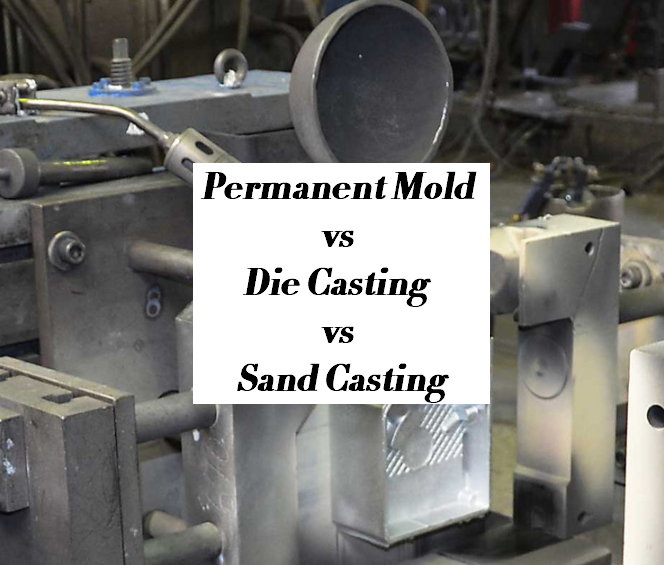Permanent Mold Casting vs Die Casting vs Sand Casting | What is Permanent Mold Casting
Casting is a big category of metal fabrication technique, there are various different types of metal casting processes. In this article, let’s compare permanent mold casting, die casting, and sand casting, to determine which one to choose for your project.

What is Permanent Mold Casting?
Permanent mold casting is the process of casting metal using reusable or permanent molds. The permanent mold casting process can be used in a variety of applications that require mass production or replication projects. Although this process is more expensive than other forms of metal casting, it is considered a cost-effective part replication method for most major industries. The most common method of permanent mold casting is to pour liquid metal into heated molds by gravity. In most cases, permanent mold casting is completed with two-piece molds. These molds are usually made of high melting point metals, such as steel, graphite, bronze, or cast iron. The two parts of the mold are closely combined, and there is an opening at the top to allow molten metal to enter. After cooling, the two molds are separated and the cast metal part is taken back for finishing.
Is Die Casting a Permanent Mold Casting?
Die casting is a permanent mold casting process in which molten metal is injected into a mold cavity under high pressure. The pressure is maintained during solidification, after which the mold is opened and casting is removed. The mold in the die casting services is called a die. Die casting machines are designed to hold and accurately close the two mold halves, and keep them closed when the molten metal is forced into the mold cavity.
Where is Permanent Molding Used?
Permanent mold casting is suitable for mass production of medium and small castings of various alloys, but it is mostly used for aluminum and copper alloys or cast iron. Permanent mold casting is usually used to make gears, suspensions, engine pistons, fuel injection housings for the automotive industry, and components for the aerospace industry.
Permanent Mold Casting vs Die Casting vs Sand Casting
What’s the difference between permanent mold casting and sand casting?
The molds used in the casting process are what distinguish permanent mold casting and die casting from sand casting. Both permanent and die casting use steel molds to form a cavity that contains molten aluminum when cooled. Sand casting will form a new cavity in the sand every cycle.
What’s the difference between permanent mold casting and die casting?
The main difference between permanent mold and die casting is how the metal enters the mold. In permanent mold casting, the metal flows from the reservoir into the cavity. The gate controls the flow rate to reduce turbulence. Typically, the mold is designed to fill from the bottom or side, with the riser at the highest point. After filling, the metal has time to freeze before opening the mold and removing the part. Features such as internal channels can be created by placing inserts in the mold before the mold is closed. Unlike gravity permanent mold casting, metal is forced into the cavity under pressure during die casting. This makes it very similar to plastic injection molding. Like permanent molds, once the metal solidifies, the mold opens and the casting is removed.
Permanent mold casting vs die casting vs sand casting, which technique to choose?
Compared with permanent mold casting or sand casting, die casting has several advantages. Through die casting, you can obtain good dimensional tolerances and little post-machining. Die casting is an ideal choice for mass production because it can produce many parts very quickly and maintain high consistency. Die castings with thinner and smoother surfaces are available. Die casting is often used when making aluminum and zinc parts. At Junying, we are able to bring quality die casting parts with on-time delivery and affordable prices.
Permanent mold casting provides you with a reusable mold that allows you to manufacture multiple parts with a good surface finish, dimensional accuracy, and high productivity. However, you can only use non-ferrous metals. In addition, the manufacturing cost of the permanent mold is relatively high. In order to make five to fifty molds in an hour, permanent mold casting must be set for several weeks. Die casting can produce castings with smaller size and thinner sections, while permanent die casting can produce stronger parts. Permanent die casting is usually used for mass production, which will make up for high die costs, although these costs are usually not as high as die casting.
Compared with die casting molds, sand casting molds are relatively cheap. This is also a good choice if you want to manufacture different types of parts in a very short production cycle. However, for larger production runs, the cost per piece of sand casting is not cost-effective because it takes a long time to reset the mold.

